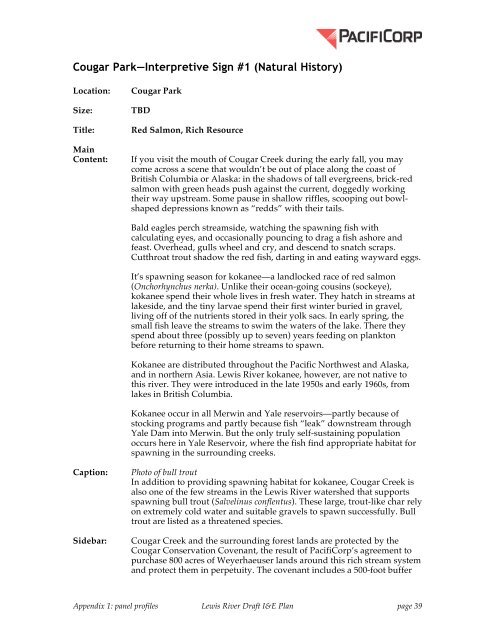The Lewis River Hydroelectric Projects - PacifiCorp
The Lewis River Hydroelectric Projects - PacifiCorp
The Lewis River Hydroelectric Projects - PacifiCorp
You also want an ePaper? Increase the reach of your titles
YUMPU automatically turns print PDFs into web optimized ePapers that Google loves.
Cougar Park—Interpretive Sign #1 (Natural History)<br />
Location:<br />
Size:<br />
Title:<br />
Main<br />
Content:<br />
Cougar Park<br />
TBD<br />
Red Salmon, Rich Resource<br />
If you visit the mouth of Cougar Creek during the early fall, you may<br />
come across a scene that wouldn’t be out of place along the coast of<br />
British Columbia or Alaska: in the shadows of tall evergreens, brick-red<br />
salmon with green heads push against the current, doggedly working<br />
their way upstream. Some pause in shallow riffles, scooping out bowlshaped<br />
depressions known as “redds” with their tails.<br />
Bald eagles perch streamside, watching the spawning fish with<br />
calculating eyes, and occasionally pouncing to drag a fish ashore and<br />
feast. Overhead, gulls wheel and cry, and descend to snatch scraps.<br />
Cutthroat trout shadow the red fish, darting in and eating wayward eggs.<br />
It’s spawning season for kokanee—a landlocked race of red salmon<br />
(Onchorhynchus nerka). Unlike their ocean-going cousins (sockeye),<br />
kokanee spend their whole lives in fresh water. <strong>The</strong>y hatch in streams at<br />
lakeside, and the tiny larvae spend their first winter buried in gravel,<br />
living off of the nutrients stored in their yolk sacs. In early spring, the<br />
small fish leave the streams to swim the waters of the lake. <strong>The</strong>re they<br />
spend about three (possibly up to seven) years feeding on plankton<br />
before returning to their home streams to spawn.<br />
Kokanee are distributed throughout the Pacific Northwest and Alaska,<br />
and in northern Asia. <strong>Lewis</strong> <strong>River</strong> kokanee, however, are not native to<br />
this river. <strong>The</strong>y were introduced in the late 1950s and early 1960s, from<br />
lakes in British Columbia.<br />
Kokanee occur in all Merwin and Yale reservoirs—partly because of<br />
stocking programs and partly because fish “leak” downstream through<br />
Yale Dam into Merwin. But the only truly self-sustaining population<br />
occurs here in Yale Reservoir, where the fish find appropriate habitat for<br />
spawning in the surrounding creeks.<br />
Caption:<br />
Sidebar:<br />
Photo of bull trout<br />
In addition to providing spawning habitat for kokanee, Cougar Creek is<br />
also one of the few streams in the <strong>Lewis</strong> <strong>River</strong> watershed that supports<br />
spawning bull trout (Salvelinus conflentus). <strong>The</strong>se large, trout-like char rely<br />
on extremely cold water and suitable gravels to spawn successfully. Bull<br />
trout are listed as a threatened species.<br />
Cougar Creek and the surrounding forest lands are protected by the<br />
Cougar Conservation Covenant, the result of <strong>PacifiCorp</strong>’s agreement to<br />
purchase 800 acres of Weyerhaeuser lands around this rich stream system<br />
and protect them in perpetuity. <strong>The</strong> covenant includes a 500-foot buffer<br />
Appendix 1: panel profiles <strong>Lewis</strong> <strong>River</strong> Draft I&E Plan page 39
















